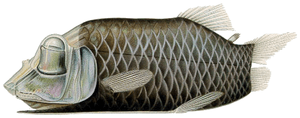Argentiniformes
| Argentiniformes | |
|---|---|
 | |
| California slickhead, Alepocephalus tenebrosus (Alepocephaloidei: Alepocephalidae) | |
| Scientific classification | |
| Kingdom: | Animalia |
| Phylum: | Chordata |
| Superclass: | Osteichthyes |
| Class: | Actinopterygii |
| Subclass: | Neopterygii |
| Infraclass: | Teleostei |
| Superorder: | Protacanthopterygii |
| Order: | Argentiniformes |
| Suborders | |
|
Alepocephaloidei | |
The Argentiniformes are an order of ray-finned fish whose distinctness was recognized only fairly recently. In former times, they were included in the Osmeriformes (typical smelt and allies) as suborder Argentinoidei. That term refers only to the suborder of marine smelts and barreleyes in the classification used here, with the slickheads and allies being the Alepocephaloidei. These suborders were treated as superfamilies Argentinoidea and Alepocephaloidea, respectively, when the present group was still included in the Osmeriformes.
They contain six or seven families with almost 60 genera and at least 228 species. A common name for the group is marine smelts and allies, but this is rather misleading since the "freshwater" smelts of the Osmeridae also live predominantly in the ocean.[1][2][3]
Description and ecology
The Argentiniformes are smallish silvery or dark and generally bathypelagic ocean fishes. Some Argentinoidei have an adipose fin, which is – unusually for Protacanthopterygii to which they belong – missing in the rest of the order. The dorsal fin is located in the second half of the body. They have a physoclistous gas bladder or lack it entirely; teeth are absent in almost all.[2]
The hypaxial muscle is unusually extended to forward at its upper end and attaches to the neurocranium below the spine, perhaps to snap the upper part of the skull down when catching prey. The primordial ligament attaches posteriorly on the upper surface of the coronoid process. The autopalatine is peculiarly expanded to above and below at its caudal end, and like in some Otocephala, the caudal part of the mesethmoid appears compressed when seen from above. As in many other teleosts, the autopterotic and dermopterotic bones are not fused together. The most distinctive characteristic, however, is the crumenal organ, also called epibranchial organ. This consists of the additional cartilage and gill rakers on the fifth ceratobranchial, which is found in other teleosts, too, but not as well-developed as in the present order.[2][3]
Systematics
The treatment of the Argentiniformes as distinct order follows the discovery that they are by no means as closely related to the Osmeriformes as was long believed. In fact, they may actually be the most basal lineage of the living Protacanthopterygii. If this is so, it would probably require either inclusion of the supposed superorders "Cyclosquamata" and "Stenopterygii" in the Protacanthopterygii, or – if the unranked clade name Euteleostei is used for this entire group – restricting the Protacanthopterygii to the Osmeriformes and either Esociformes or Salmoniformes and establishing a monotypic superorder for the other of the two latter orders. Given the reluctance of modern zoologists to establish monotypic taxa if not absolutely necessary, the former treatment is probably preferable.[3]
The classification of the Argentiniformes is:[1][2][3]
- Suborder Alepocephaloidei
- Family Alepocephalidae – typical slickheads (includes species formerly in Bathylaconidae)
- Family Leptochilichthyidae – aberrant slickheads
- Family Platytroctidae (including Searsiidae)

- Suborder Argentinoidei
- Family Argentinidae – herring smelts
- Family Bathylagidae – deep-sea smelts (sometimes included in the Microstomatidae)
- Family Microstomatidae – pencil smelts
- Family Opisthoproctidae – barreleyes
A fossil family that might belong in this order are the Pattersonellidae.[2]
References
- 1 2 FishBase (2006): Order Osmeriformes. Version of 2006-OCT-09. Retrieved 2009-SEP-28. pp. 190-194
- 1 2 3 4 5 Nelson, Joseph S. (2006): Fishes of the World (4th ed.). John Wiley & Sons, Inc. ISBN 0-471-25031-7
- 1 2 3 4 Diogo, Rui (2008): On the cephalic and pectoral girdle muscles of the deep sea fish Alepocephalus rostratus, with comments on the functional morphology and phylogenetic relationships of the Alepocephaloidei (Teleostei). Anim. Biol. 58(1): 23-29. doi:10.1163/157075608X303636
| Wikimedia Commons has media related to Argentiniformes. |
| Wikispecies has information related to: Argentinoidei |